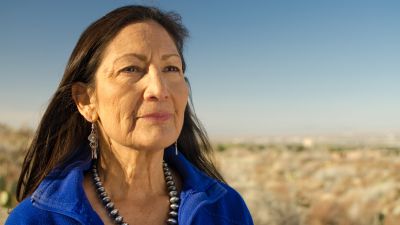
Groups rally to ask Gov. Cuomo to protect New York state water by denying required water quality certificate for Constitution Pipeline. (Photo by Eric McGregor/Pacific Press/LightRocket via Getty Images)
This post originally appeared at Yes! Magazine.
Back in March, when Donald Trump was facing off with two now-forgotten candidates for the Republican Party’s presidential nomination, the small town of Barnstead, New Hampshire, was quietly protecting its citizens. At their annual town hall, residents voted unanimously for a city ordinance establishing the right to freedom from forced religious identification.
This inconspicuous action was part of a growing national movement for strengthened community self-governance that has found new purpose as the reality of a Trump presidency fast approaches. It came in the form of a community bill of rights, a charter or ordinance that affirms certain rights within a municipality. Similar bills have granted the right to a clean environment, safe and affordable housing, health care and worker’s rights, among others.
President-elect Trump’s campaign promises, proposed policies and Cabinet appointments offer little confidence that environmentalists, women, people of color, low-wage workers, Muslims, immigrants and those who identify as LGBTQ will find protection in federal-level policies. In the years to come, community bills of rights are one strategy for cities across the nation to continue to shelter such populations.
In fact, many cities have already begun. At least 10 major sanctuary cities have reaffirmed their position as such, and some, including San Francisco, have released statements or passed ordinances pledging noncooperation with Trump’s policies. Some municipalities, such as Grant Township in Pennsylvania, already have existing community bills of rights.
In Grant, as is often the case, this legislation arose out of environmental battles. “A few years back, the EPA announced a public hearing about an injection well,” said Stacy Long, an elected official on Grant’s Board of Supervisors. “We were horrified, and thought we would simply clue the EPA in on what a terrible idea it would be in our community.”
But residents quickly realized the EPA was likely to issue a permit. Looking for a different strategy, community members turned to the Community Environmental Legal Defense Fund (CELDF), a nonprofit organization that champions community rights through education and legal support. It worked with Grant Township to write a community bill of rights, which, among other things, included a ban on storing fracked water.
“[Communities] can spend years with normal environmental battles, only to find that they do not have much authority to make a decision at the local level,” said Mari Margil, associate director of CELDF. “We go back with them and help them figure out: Why did they end up in this situation they are in, where they don’t have much in the way of local democratic decision-making authority.”
CELDF’s strategy is fundamentally different from that of other environmental organizations. Instead of working through normal legal channels of permitting and suing, where Margil said activists “can spend years, only to end up getting the thing they did not want,” CELDF works to grant communities fundamental rights over their own natural resources, as was the case in Grant Township. Instead of battling with the gas companies, Grant declared “All residents of Grant Township, along with natural communities and ecosystems within the Township, possess the right to clean air, water and soil.”
The General Council of the Ho-Chunk Nation of Wisconsin went a step further this September when it voted to amend its constitution to grant rights to nature itself. If approved by the tribe, the constitution will proclaim: “Ecosystems and natural communities within the Ho-Chunk territory possess an inherent, fundamental and inalienable right to exist and thrive.”
The Ho-Chunk made their stand in solidarity with the Standing Rock Sioux and in recognition of the destructive impact of fossil fuel extraction and development. This type of support demonstrates the role that community rights laws could play under Trump, who has pledged to expand fossil fuel extraction and dissolve the EPA.
Environmental battles often pave the way for human rights protections, as was the case with the Barnstead law. It was aimed directly at Trump’s proposed ban on Muslim immigration and followed on the coattails of another community rights law that prevented water privatization.
“Before the election, I was listening to Trump and getting very concerned,” said Kati Preston, who championed the bill. “I am a Holocaust survivor and know that, in New Hampshire, you can pass laws locally.”
New Hampshire’s uniquely independent political climate makes opposing local legislation an unpopular move for elected officials. But in most states, power — and funding — held at higher levels make local legislation a soft target. State governments preempt local governments, and the Federal government preempts the state. CELDF thus makes a philosophical argument that pushes up against preemption.
“Communities are arguing that they have a right to local governance,” Margil said. “We have a fundamental violation of our democratic rights when we have a state legislature that is overriding our ability to protect our communities, protect our people, protect our land. It is a right to community self-governance that is being usurped by industry, by corporations, by state legislatures working hand-in-hand with corporations.”
Pre-emption is one of the pitfalls of community bills of rights, as those in Morgantown, West Virginia, discovered. In 2011, the city passed a local ban on horizontal drilling and fracking within 2 miles of town. Within days, a company seeking to drill in the area sued, claiming the city did not have jurisdiction to regulate such activity. A local circuit court agreed, finding cities to be “creatures of the state.”
In 2012, two New York state judges ruled differently. In response to separate municipal fracking bans, they ruled that local governments do, in fact, have the right to set their own environmental laws. These decisions were a victory for local governments on specific issues. But the idea of the right of communities to local self-government will likely be tested under a Trump administration.
The balance between federal, state and local governments indeed has a long and fraught history that does not necessarily reflect the progressive intentions of CELDF. Calls for local autonomy and states’ rights have echoed throughout history with nasty undertones. Since pre-Civil War America, Southern states asserted local control to maintain the institution of slavery, and Confederate states insisted that they were suffering under federal government infringement. Later, the phrase cropped in segregationists’ response to the civil rights movement, and then again in Richard Nixon’s presidential campaign, which used the phrase “states’ rights” to pander to Southern voters.
And local-level defiance certainly has a similar flavor to the obstructionism common during the Obama administration. Five states initially refused to comply with major provisions of the Affordable Care Act, and after the Supreme Court ruled that bans on gay marriage were unconstitutional, many states defied the ruling and maintained such bans. In fact, in his critique of the ruling, Texas Attorney General Ken Paxton said the court’s ruling reaffirmed the state’s “resolve to … return to democratic self-government.”
Despite its speckled past, local self-governance may play an important role under a Trump administration. Although community bills of rights may not have fully sharpened legal teeth, they do offer assurance to a frightened citizenry and direction to cities wanting to protect civil liberties and work toward environmental sustainability. Although they may be barred from executing policies that conflict with state or federal laws, cities and towns can continue to plan for climate change mitigation, offer social services and fight hate crime. Community bills of rights provide a framework for these and other measures.
Perhaps the most vital role they play is when considering how change happens. It is often iterative: Pioneers lay the moral and legal foundation that creates an impetus for broader change. Early desegregationists set the stage for the civil rights movement.
“I think it is a beginning,” Preston said of her community’s anti-religious-persecution law. “If it spreads, it will send a message that we do not want [religious registration] laws. It is simply that: unless you stand up and be counted, bad things will happen.”




